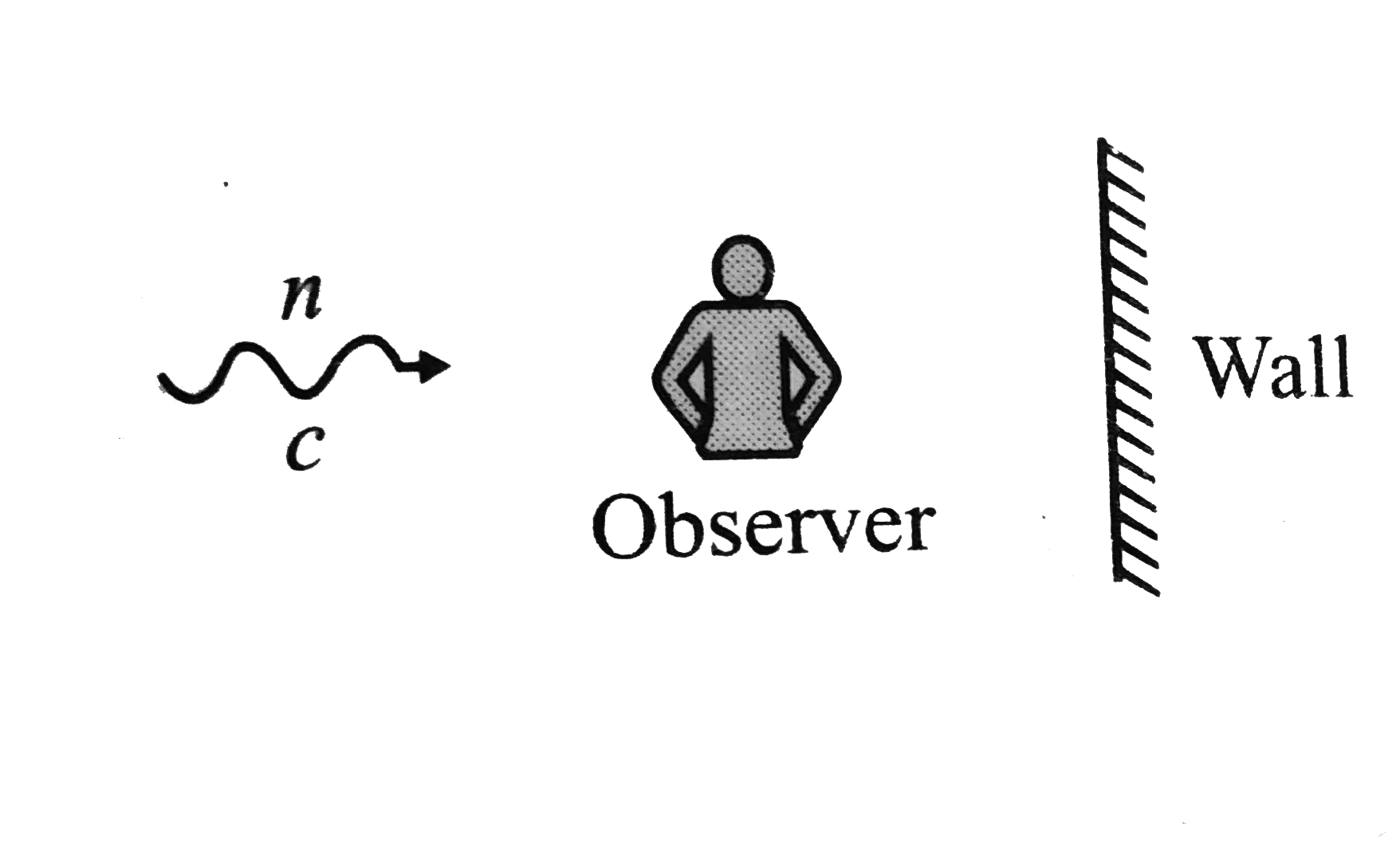A source emits sound waves of frequency 1000HZ. The source moves to the right with a speed of 32m/s relative to ground. On the right a reflecting surface moves towards left with a speed of 64m/s relative to the ground. The speed of sound in air is 332m/s. Find
(a) the wavelength of sound in aheed of the source,
(b) the number of waves arriving per second which meets the reflecting surface,
(c ) the speed of reflected waves and
(d) the wavelength of reflected waves.
(a) Due to motion of the source the wavelength (and hence the frequency) is actually changed from λ and λ' such that if n= actual frequency.
λ'=c−vSn=332−321000=0.3m
(b) The number of waves arriving at the reflecting surface is the same as the number of waves received by an observer moving towards the source. This is given by the apparent frequency.
n'=c−v0c−vS×n
=332−(−64)332−32×1000=1320Hz
(c ) Same as that of the incident wave because the speed of wave depends only on the characteristics of the medium. therefore, speed of the reflected wave=332ms−1
(d) Now reflector will act as a source of frequency 1320 Hz. So wavelength emitted by this:
λ'=v−vref1320=332−641320=0.2m
Topper's Solved these Questions
- SOUND WAVES AND DOPPLER EFFECTBOOK - CENGAGE PHYSICS ENGLISHCHAPTER - SOUND WAVES AND DOPPLER EFFECTEXERCISE - Subjective
56 Videos
- SOUND WAVES AND DOPPLER EFFECTBOOK - CENGAGE PHYSICS ENGLISHCHAPTER - SOUND WAVES AND DOPPLER EFFECTEXERCISE - Single Correct
252 Videos
- SOUND WAVES AND DOPPLER EFFECTBOOK - CENGAGE PHYSICS ENGLISHCHAPTER - SOUND WAVES AND DOPPLER EFFECTEXERCISE - Exercise 6.1
56 Videos
- RIGID BODY DYNAMICS 2BOOK - CENGAGE PHYSICS ENGLISHCHAPTER - RIGID BODY DYNAMICS 2EXERCISE - Interger
2 Videos
- SUPERPOSITION AND STANDING WAVESBOOK - CENGAGE PHYSICS ENGLISHCHAPTER - SUPERPOSITION AND STANDING WAVESEXERCISE - Comprehension Type
5 Videos
Similar Questions
A source of sound of frequency 1000 Hz moves to the right with a speed of 32ms relative to the ground. To its right there is a reflecting surface moving to the left with a speed of 64ms relative to the ground. Take the speed of 64ms. Relative to the ground. Take the speed of sound in air to be 332ms and find
(a) The wavelength of the sound emitted in air by the source,
(b) the number of waves per second arriving at the reflecting surface,
(c ) The speed of the reflected waves and
(d) The wavelength of the reflected waves.
View SolutionA source of sound of frequency 1000 Hzmoves to the right with a speed of 50 m/s relative to the ground. To its right is a reflecting surface moving to the left as shown in figure. Speed of the sound in air is 330 m/s.


View SolutionSpeed of sound in air is 330m/s.Find maximum and minimum wavelength of audible sound in air.
View SolutionA plice siren emits a sound wave of frequency 440 Hz. The speed of sound is 332 m/s. if the siren is moving away from the listerner with a speed of 18 m/s relative to the air and the listerner is moving towards the siren with a speed of 68 m/s relative to the air, then what frequency does the listern hear?
View SolutionThe speed of sound waves in air at 300K is 332 m/s. At what temperature will the speed be 574 m/s
View SolutionA sound source moves with a speed of 80m/s relative to still air toward a stationary listener. The frequency of sound is 200HZ and speed of sound in air is 340m/s. (a) Find the wavelength of the sound between the source and the listener. (b) Find the frequency heard by the listener.
View SolutionIf speed of sound in air is 340 m/s and in water is 1480 m/s.If frequency of sound is 1000 kHz, then find wavelength in water
View SolutionSpeed of sound in air 332 m/s at NTP. What will the speed of sound in hydrogen at NTP if the density of hydrogen at NTP is (1/16) that of air.
View SolutionIn an organ pipe the distance between the adjacent node is 4cm. Find the frequency of source if speed of sound in air is 336m/s.
View Solution
A sound wave of frequency n travels horizontally to the right with speed with speed c. It is reflected from a broad wall moving to the left with speed v. The number of beats heard by a stationary observer to the left of the wall is
View Solution
